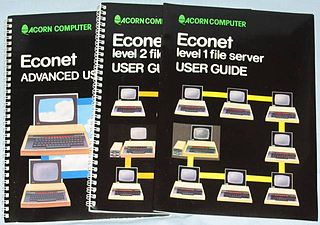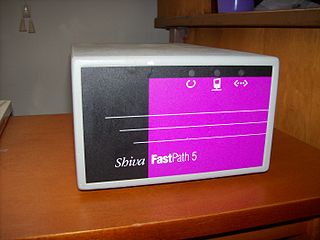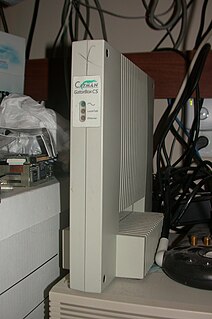Related Research Articles
AppleTalk is a discontinued proprietary suite of networking protocols developed by Apple Inc. for their Macintosh computers. AppleTalk includes a number of features that allow local area networks to be connected with no prior setup or the need for a centralized router or server of any sort. Connected AppleTalk-equipped systems automatically assign addresses, update the distributed namespace, and configure any required inter-networking routing.

Wake-on-LAN (WoL) is an Ethernet or Token Ring computer networking standard that allows a computer to be turned on or awakened by a network message.

3Com Corporation was a digital electronics manufacturer best known for its computer network products. The company was co-founded in 1979 by Robert Metcalfe, Howard Charney and others. Metcalfe explained the name 3Com was a contraction of "Computer Communication Compatibility", with its focus on Ethernet technology that he had co-invented, which enabled the networking of computers.
A network switch is networking hardware that connects devices on a computer network by using packet switching to receive and forward data to the destination device.
A network operating system (NOS) is a specialized operating system for a network device such as a router, switch or firewall.
Xerox Network Systems (XNS) is a computer networking protocol suite developed by Xerox within the Xerox Network Systems Architecture. It provided general purpose network communications, internetwork routing and packet delivery, and higher level functions such as a reliable stream, and remote procedure calls. XNS predated and influenced the development of the Open Systems Interconnection (OSI) networking model, and was very influential in local area networking designs during the 1980s. It had little impact on TCP/IP, however, which was designed earlier.
AppleShare was a product from Apple Computer which implemented various network services. Its main purpose was to act as a file server, using the AFP protocol. Other network services implemented in later versions of AppleShare included a print server using the Printer Access Protocol (PAP), web server, electronic mail server, and SMB / CIFS server to support file sharing to Microsoft Windows clients.

RISC iX is a discontinued Unix operating system designed to run on a series of workstations based on the Acorn Archimedes microcomputer. Heavily based on 4.3BSD, it was initially completed in 1988 – a year after Arthur but prior to RISC OS. It was introduced in the ARM2-based R140 workstation in 1989, followed up by the ARM3-based R200-series workstations in 1990.

Econet was Acorn Computers's low-cost local area network system, intended for use by schools and small businesses.
HP Jetdirect is the name of a technology sold by Hewlett-Packard that allows computer printers to be directly attached to a Local Area Network. The "Jetdirect" designation covers a range of models from the external 1 and 3 port parallel print servers known as the 300x and 500x, to the internal EIO print servers for use with HP printers. The Jetdirect series also includes wireless print server models, as well as gigabit Ethernet and IPv6-compliant internal cards.
In computer networking, TUN and TAP are kernel virtual network devices. Being network devices supported entirely in software, they differ from ordinary network devices which are backed by physical network adapters.

The Kinetics FastPath was a LocalTalk-to-Ethernet bridge created in 1985 to allow Apple Macintosh computers to communicate with other computers on Ethernet networks. The product had five significant revisions during its lifetime and was ultimately sold to Shiva Networks late in its existence. The original FastPath was developed to extend AppleTalk on Ethernet for Apple Computer, but from the beginning it was also modeled after an implementation of the Stanford Ethernet - AppleTalk Gateway (SEAGATE) created at Stanford University Medical Center by Bill Croft in 1984 and 1985. SEAGATE was a combination of hardware and software that picked up IP packets from the Ethernet network and encapsulated them inside of DDP packets on the AppleTalk network and conversely picked up specially-encoded DDP packets on the AppleTalk network and placed them on the Ethernet network as IP packets.
MacIP refers to a standard for encapsulating Internet Protocol (IP) packets within the AppleTalk DDP protocol. This allows Macintosh computers with LocalTalk networking hardware to access the normally Ethernet-based connections for TCP/IP based network services. This was an important bridging technology during the era when Ethernet and TCP/IP were rapidly growing in popularity in the early 1990s.

The GatorBox is a LocalTalk-to-Ethernet bridge, a router used on Macintosh-based networks to allow AppleTalk communications between clients on LocalTalk and Ethernet physical networks. The GatorSystem software also allowed TCP/IP and DECnet protocols to be carried to LocalTalk-equipped clients via tunneling, providing them with access to these normally Ethernet-only systems.
TOPS is a peer-to-peer LAN-based file sharing system best known in its Macintosh implementation, but also available for DOS and able to interoperate with Unix's NFS. Originally written by Centram Systems West, the company was purchased by Sun Microsystems as part of Sun's development of the NFS ecosystem. The Centram company was renamed to TOPS after its acquisition by Sun. Sales of TOPS dried up after the introduction of System 7, which featured a similar file sharing system built-in, and Sun spun off their NFS developments to Sitka.
Data center bridging (DCB) is a set of enhancements to the Ethernet local area network communication protocol for use in data center environments, in particular for use with clustering and storage area networks.
Excelan was a computer networking company founded in 1982 by Kanwal Rekhi, Inder Singh and Navindra Jain. Excelan was a manufacturer of smart Ethernet cards, until the company merged with, and was acquired by Novell in 1989. The company offered a line of Ethernet "front end processor" boards for Multibus, VMEbus, Q-Bus, Unibus, and IBM AT Bus systems. The cards were equipped with their own processor and memory, and ran TCP/IP protocol software that was downloaded onto the cards from the host system. Excelan offered software like LAN Workplace that integrated the cards into a variety of operating system environments, including many flavors of UNIX, RSX-11, VMS, and DOS. The hardware and software were sold under the EXOS brand. In 1987, Excelan also acquired Kinetics, a small networking company that manufactured and sold a variety of Ethernet networking products for Apple Macintosh environments, most notably an AppleTalk-to-Ethernet gateway called the FastPath.

SoftEther VPN is free open-source, cross-platform, multi-protocol VPN client and VPN server software, developed as part of Daiyuu Nobori's master's thesis research at the University of Tsukuba. VPN protocols such as SSL VPN, L2TP/IPsec, OpenVPN, and Microsoft Secure Socket Tunneling Protocol are provided in a single VPN server. It was released using the GPLv2 license on January 4, 2014. The license was switched to Apache License 2.0 on January 21, 2019.
References
- ↑ Ether Route II User Manual. Compatible Systems. Retrieved 29 January 2021.
- ↑ RISC Router 3000E Installation Guide (PDF). Compatible Systems. Retrieved 29 January 2021.
- ↑ "Webster Multiport/Lt Product Guide" (PDF). Vintage Technology Digital Archive. Webster Computer Corporation. Retrieved 31 July 2020.
- ↑ Apple IP Gateway press release Archived 2008-10-13 at the Wayback Machine